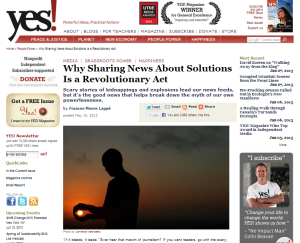Nonviolence Currents – Bridging Nonviolence and Current Events in the Classroom
A service of the Metta Center for Nonviolence
LESSON PLAN #3
YES! Magazine Article: Why Telling the Stories of Solutions is a Revolutionary Act by Frances Moore Lappe
Themes: media literacy, problem solving, critical thinking, writing for media
Target age group: Ages 14 & up
Subject areas: Language Arts, Media Literacy, Social Studies
Pre-reading: Ask students to skim the article and look up the words they don’t know (examples: maxim, amygdala).
Pre-reading discussion questions:
-
Do you watch, listen to, or read the news? What are your primary news sources? Why? On the board, brainstorm news sources and categorize them (TV, radio, newspaper, blog, internet sites etc).
-
Did anyone hear/read/watch the news this morning? What were the main stories? What kind of stories were they?
-
What positive news stories have you heard lately in the media?
-
How does the media contribute to a culture of violence?
-
How does the media portray human nature?
Reading: Set aside time in class to read the article (10-15 minutes) or assign the reading for homework the night before class.
-
The author writes the maxim, “If it bleeds, it leads.” Why does violent news make headlines? Why does scary news “sell”? (Note: the Dalai Lama says that violent news makes headlines because it is an anomaly – most people do not act violently, but that when they do, it is abnormal and makes the news. However, because the news heavily focuses on violence this gives us a false impression of the proportion of violence in society).
-
Do you agree with the author that sharing news about solutions is revolutionary? Why or why not?
-
Why is thinking in terms of solutions revolutionary? Do you agree that when we think in terms of solutions we are more likely to make a better world possible? How? How does this apply in our daily lives and daily conversations in general?
-
Nonviolence is more than about protesting what you don’t like; it also means creating the world you want to see by building solutions that work for everyone. How does constructive thinking challenge us? How can thinking about solutions make the world a more nonviolent and safe place?
Post-reading activities:
Activity #1 – Exploring Alternative Media: In small groups, have students research the solution-oriented media sites that the author lists at the end of the article, assigning each group to a different site. Have each group make a presentation on the site’s mission and top 3 stories. As a class, compare the top 3 stories on each site, and see what the similarities and differences are.
Activity #2 – Stories of Solutions: Individually or in groups, have students write a positive news story about something that is happening locally (in the school, local community, region, etc). As a class, create a Stories of Solutions newsletter (paper, electronic, or blog) to share with the rest of the school.
Activity #3 – Self-Reflection: Ask students to do the following exercise: evaluate your communications on text messaging, email, phone and social media for a day. Note when instead of offering positive ideas and constructive thinking, you follow the negative news model. Experiment for a day to make all of your communications reflect revolutionary constructive thinking and solutions. Write or discuss how it made you feel to try this experiment, include what was challenging as well as rewarding.
Activity #4 – Positive Social Media Exercise: We once heard about a high school student who started a Twitter feed to encourage his fellow classmates with positive messages. Ask students to think of a way that they might use social media to encourage positive, solution-based thinking. For example, they might use text-messaging to send daily encouragement to their family or friends. Think big!
Activity #5 – Media Fast: Ask students to become aware of the influence of all negative media and advertising on their state of mind for one day. For example, if they see a story about war or violence, ask them to notice how they feel (physically, emotionally, etc.) as they hear or watch this story. After this day, ask students to conduct a “media fast” where you turn off the TV, cell-phone, etc. for one day. After the fast, have students write or discuss how it made them feel to try this experiment, include what was challenging as well as what they learned about themselves. For an additional resource on media fasting, check out this resource from PBS.
Extension: Try the Not So Fair and Balanced: Analyzing Bias in the Media lesson from the Institute for Humane Education and watch the Solutionaries TED talk with Zoe Weil
Additional Resource: The Center for Media Literacy’s Five Key Questions for media literacy
Lesson plan created and developed by Stephanie Knox Cubbon and Stephanie Van Hook of the Metta Center for Nonviolence.
If you have any questions about this lesson, or if you use it and would like to tell us how it went, please write to use at education@mettacenter.org. We would love to hear from you!










